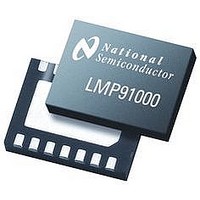LMP91000SDE/NOPB National Semiconductor, LMP91000SDE/NOPB Datasheet - Page 11

LMP91000SDE/NOPB
Manufacturer Part Number
LMP91000SDE/NOPB
Description
IC AFE INTERFACE 14-LLP
Manufacturer
National Semiconductor
Datasheet
1.LMP91000SDENOPB.pdf
(24 pages)
Specifications of LMP91000SDE/NOPB
Number Of Channels
1
Voltage - Supply, Analog
2.7 V ~ 5.25 V
Voltage - Supply, Digital
2.7 V ~ 5.25 V
Package / Case
14-WFDFN Exposed Pad
Input Voltage
5.25V
Supply Current
10µA
Ic Output Type
Analog
Sensor Case Style
QFN
No. Of Pins
14
Supply Voltage Range
2.7V To 5.25V
Rohs Compliant
Yes
Lead Free Status / RoHS Status
Lead free / RoHS Compliant
Power (watts)
-
Number Of Bits
-
Lead Free Status / Rohs Status
Compliant
Other names
LMP91000SDE/NOPBTR
Available stocks
Company
Part Number
Manufacturer
Quantity
Price
Part Number:
LMP91000SDE/NOPB
Manufacturer:
TI/德州仪器
Quantity:
20 000
Function Description
GENERAL
The LMP91000 is a programmable AFE for use in micropower
chemical sensing applications. The LMP91000 is designed
for 3-lead single gas sensors and for 2-lead galvanic cell sen-
sors. This device provides all of the functionality for detecting
changes in gas concentration based on a delta current at the
working electrode. The LMP91000 generates an output volt-
age proportional to the cell current. Transimpedance gain is
user programmable through an I
2.75kΩ to 350kΩ making it easy to convert current ranges
from 5µA to 750µA full scale. Optimized for micro-power ap-
plications, the LMP91000 AFE works over a voltage range of
POTENTIOSTAT CIRCUITRY
The core of the LMP91000 is a potentiostat circuit. It consists
of a differential input amplifier used to compare the potential
between the working and reference electrodes to a required
working bias potential (set by the Variable Bias circuitry).
The error signal is amplified and applied to the counter elec-
trode (through the Control Amplifier - A1). Any changes in
the impedance between the working and reference elec-
trodes will cause a change in the voltage applied to the
counter electrode, in order to maintain the constant voltage
between working and reference electrodes. A Tran-
simpedance Amplifier connected to the working electrode,
is used to provide an output voltage that is proportional to the
cell current. The working electrode is held at virtual ground
(Internal ground) by the transimpedance amplifier. The po-
tentiostat will compare the reference voltage to the desired
bias potential and adjust the voltage at the counter electrode
to maintain the proper working-to-reference voltage.
Transimpedance amplifier
The transimpedance amplifier (TIA in
grammable internal gain resistors. This accommodates the
full scale ranges of most existing sensors. Moreover an ex-
ternal gain resistor can be connected to the LMP91000 be-
tween C1 and C2 pins. The gain is set through the I
interface.
2
C compatible interface from
Figure
FIGURE 2. System Block Diagram
2) has 7 pro-
2
C
11
2.7V to 5.25 V. The cell voltage is user selectable using the
on board programmability. In addition, it is possible to connect
an external transimpedance gain resistor. A temperature sen-
sor is embedded and it can be power cycled through the
interface. The output of this temperature sensor can be read
by the user through the VOUT pin. It is also possible to have
both temperature output and output of the TIA at the same
time; the pin C2 is internally connected to the output of the
transimpedance (TIA), while the temperature is available at
the VOUT pin. Depending on the configuration, total current
consumption for the device can be less than 10µA. For power
savings, the transimpedance amplifier can be turned off and
instead a load impedance equivalent to the TIA’s inputs
impedance is switched in.
Control amplifier
The control amplifier (A1 op amp in
a) providing initial charge to the sensor, b) providing a bias
voltage to the sensor. A1 has the capability to drive up to 10-
mA into the sensor in order to to provide a fast initial condi-
tioning. A1 is able to sink and source current according to the
connected gas sensor (reducing or oxidizing gas sensor). It
can be powered down to reduce system power consumption.
However powering down A1 is not recommended, as it may
take a long time for the sensor to recover from this situation.
Variable Bias
The Variable Bias block circuitry
amount of bias voltage required by a biased gas sensor be-
tween its reference and working electrodes. The bias voltage
can be programmed to be 1% to 24% (14 steps in total) of the
supply, or of the external reference voltage. The 14 steps can
be programmed through the I
bias can be also programmed.
Internal zero
The internal Zero is the voltage at the non-inverting pin of the
TIA. The internal zero can be programmed to be either 67%,
50% or 20%, of the supply, or the external reference voltage.
This provides both sufficient headroom for the counter elec-
trode of the sensor to swing, in case of sudden changes in the
gas concentration, and best use of the ADC’s full scale input
range.
2
C interface. The polarity of the
(Figure
Figure
30132583
2) has two tasks:
2) provides the
www.national.com












